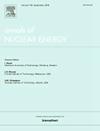Energy-dependent neutron removal cross-section
IF 1.9
3区 工程技术
Q1 NUCLEAR SCIENCE & TECHNOLOGY
引用次数: 0
Abstract
This study provides new, essential data and models for the monoenergetic neutron removal cross-section required for neutron shielding. A Monte Carlo model using CERN FLUKA code was developed to calculate the energy-dependent removal cross-section for elements commonly used in radiation shielding materials. Neutron energies ranging from 0.5 to 20 MeV including the fusion neutrons at 2.5 and 14.1 MeV were analyzed to generate the required data. Unlike previous approaches, which often rely on approximations or limited datasets, this study provides comprehensive and precise models that describe energy-dependent removal cross-sections as functions of atomic weight and total neutron cross-section. The new models were successfully applied to neutron energies of 2.5 MeV and above, with enhanced accuracy for fission neutrons. The calculated removal cross-section data were compared with prior measurements and calculations, demonstrating the model’s capability to accurately predict the energy-dependent removal cross-sections for shielding materials such as iron, graphite, aluminum, lead, barite concrete, borosilicate glass, and polyethylene.
求助全文
约1分钟内获得全文
求助全文
来源期刊

Annals of Nuclear Energy
工程技术-核科学技术
CiteScore
4.30
自引率
21.10%
发文量
632
审稿时长
7.3 months
期刊介绍:
Annals of Nuclear Energy provides an international medium for the communication of original research, ideas and developments in all areas of the field of nuclear energy science and technology. Its scope embraces nuclear fuel reserves, fuel cycles and cost, materials, processing, system and component technology (fission only), design and optimization, direct conversion of nuclear energy sources, environmental control, reactor physics, heat transfer and fluid dynamics, structural analysis, fuel management, future developments, nuclear fuel and safety, nuclear aerosol, neutron physics, computer technology (both software and hardware), risk assessment, radioactive waste disposal and reactor thermal hydraulics. Papers submitted to Annals need to demonstrate a clear link to nuclear power generation/nuclear engineering. Papers which deal with pure nuclear physics, pure health physics, imaging, or attenuation and shielding properties of concretes and various geological materials are not within the scope of the journal. Also, papers that deal with policy or economics are not within the scope of the journal.
 求助内容:
求助内容: 应助结果提醒方式:
应助结果提醒方式:


